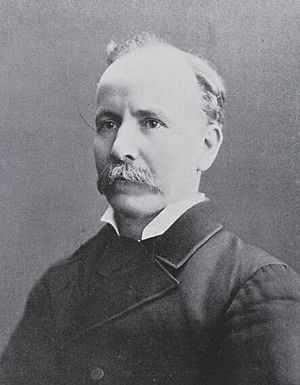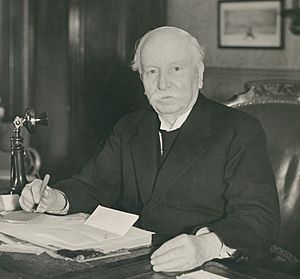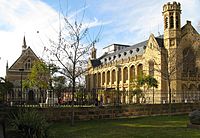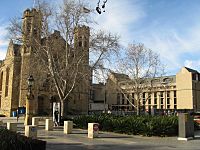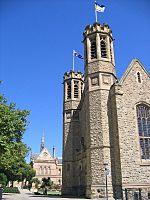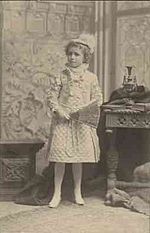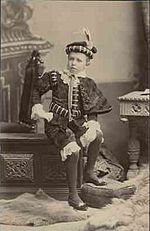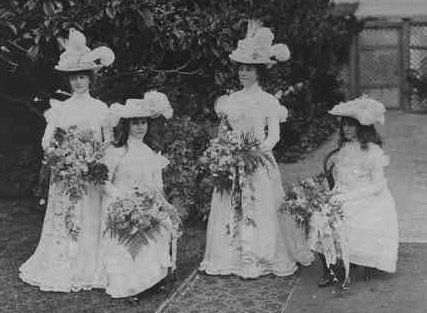John Langdon Bonython facts for kids
Quick facts for kids
Sir Langdon Bonython
|
|
|---|---|
 |
|
| Member of the Australian Parliament for South Australia |
|
| In office 30 March 1901 – 16 December 1903 Serving with Lee Batchelor, Paddy Glynn, Frederick Holder, Charles Kingston, Alexander Poynton and Vaiben Louis Solomon
|
|
| Member of the Australian Parliament for Barker |
|
| In office 16 December 1903 – 8 November 1906 |
|
| Preceded by | New seat |
| Succeeded by | John Livingston |
| Personal details | |
| Born | 15 October 1848 London, England |
| Died | 22 October 1939 (aged 91) Adelaide, South Australia |
| Nationality | Cornish Australian |
| Political party | Protectionist Party |
| Spouse | Mary Louisa Fredericka Balthasar |
| Occupation | Journalist |
Sir John Langdon Bonython (born 15 October 1848, died 22 October 1939) was a very important person in early Australian history. He was a successful journalist and owned newspapers. He was also a kind person who gave a lot of money to help others, which is called a philanthropist.
Sir John was a politician too. He was a member of the very first Australian Parliament. For 35 years, he was the editor of The Advertiser, a big daily newspaper in Adelaide.
Contents
Early Life and Family
John Langdon Bonython was born in London, England, in 1848. He was the second son of George Langdon Bonython and Annie MacBain. When John was six years old, his family moved to South Australia in July 1854.
He went to school at Brougham School in North Adelaide. In 1870, he married Mary Louisa Fredericka Balthasar. They had eight children together. Sadly, only six of their children lived past infancy.
A Career in Media
When John was just sixteen, he started working at The Advertiser newspaper. He was known for being a very hard worker. In 1879, he became a part-owner of the newspaper. This was a big step in his career.
By 1894, John Bonython owned The Advertiser completely. He also became its editor. He held these important jobs for another 35 years. During this time, he also added two other newspapers, the weekly Chronicle and the evening Express, to his company.
He retired from his newspaper work in 1929. By then, he had worked in the newspaper business for 65 years! When he sold The Advertiser, it was for a huge amount of money, £1,250,000.
Political Contributions
Even though he was busy with newspapers, John Bonython also served his country. After the Federation in 1901, when Australia became one nation, he decided to enter politics. He was chosen to represent South Australia in the Australian House of Representatives. He was part of the Protectionist Party.
In the 1901 election, he was one of seven people elected from South Australia. At that time, South Australia was one large voting area with many representatives. In the 1903 election, he was elected without anyone running against him for the new area called Division of Barker.
John Bonython helped with important government work. In 1904, he was on a special committee that looked into old-age pensions. Pensions are payments given to people after they retire. He also served on a Royal Commission about pensions in 1905–1906.
He decided not to run for re-election in 1906 and left politics. In 1908, he received an award called the Companion of the Order of St Michael and St George (CMG). This was to thank him for his service to Australia.
Public Service and Giving Back
Sir John Bonython was very dedicated to helping his community. In 1883, he became the chairman of the Adelaide School Advisory Board. He also led the council for the South Australian School of Mines and Industries from 1889 until he died. He often gave his own money to help this school. He even paid for the chemical and metallurgical laboratories there.
From 1895 to 1902, he was the chairman of the council for the agricultural college at Roseworthy. He was knighted in 1898, which means he was given the title "Sir."
He also helped soldiers returning from war. He was a trustee for a program that helped soldiers in 1916. In 1917, he became a commissioner for the Australian Soldiers Repatriation Act.
In 1916, he joined the council of the University of Adelaide. He gave over £50,000 to build a large hall there. He also gave £20,000 to fund a Chair (a special teaching position) in law. From 1916 to 1926, he was the deputy chairman of the South Australian advisory council of education. He even donated £100,000 towards building Parliament House in Adelaide.
In 1919, he received an even higher award, becoming a Knight Commander of the Order of St Michael and St George (KCMG). This was also for his great service to Australia.
He was also involved with the Royal Institution of Cornwall in England, where his family came from. He was vice-president and then president. He gave £2,000 to the Royal Cornwall Museum building fund. A gallery there is named after him.
His wife, Lady Bonython, also helped many charities. She worked with the Kindergarten Union and the State Children's Council.
Bonython Hall at the University of Adelaide
Sir John's Legacy
Sir John Bonython passed away in 1939. He left behind a very large estate, over £4,000,000. This was one of the biggest fortunes in Australia at the time. He left money to many places, including the Pilgrim Uniting Church, where he worshipped, and St Peter's Cathedral, Adelaide. He also gave money to the Salvation Army.
His Children
Sir John Bonython and Mary Louisa Fredericka Balthasar married on 24 December 1870. Mary was also known as Marie Louise Friedrike or Marie Louise Frederica. After John was knighted in 1898, she became known as Lady Bonython. She passed away in 1924.
They had eight children. Three daughters and three sons lived to adulthood. Sir John outlived his wife and four of his children. He was survived by three daughters and one son, John Lavington Bonython.
His children included:
- (1872–1873) Clive Hereward Bonython
- (1874–1956) Mary Elsie Bonython, later Lady Parsons.
- (1875–1960) Sir John Lavington Bonython, who became a Lord Mayor of Adelaide.
- (1877–?) Edith Annie Bonython
- (1879–1915) Hugh Trevarnon Bonython
- (1881–?) Ada Langdon Bonython
The Bonython Family Name
The Bonython family came from Cornwall, a region in England. They were a well-known family during the Tudor and Stuart periods. Sir John was very interested in his family history. He had many books about Cornish history. He also supported the South Australian Cornish Association.
He was sad that he couldn't buy back Bonython Manor, his family's original home in Cornwall. In 1908, he bought a large house in North Adelaide and named it 'Carclew'. This was after an area in Cornwall where his ancestors lived.
Sir John explained that "Bonython" is a Cornish name. The accent is on the second part: Bon-y'thon, with the 'y' sounding like the 'y' in 'spy'. His family had lived in the Lizard district of Cornwall since at least 1277.
Awards and Honours
Sir John Langdon Bonython received several important awards for his service:
- In 1898, he was knighted, becoming "Sir John."
- In 1908, he was made a Companion of the Order of St Michael and St George (CMG).
- In 1919, he was promoted to Knight Commander of that Order (KCMG).
In 1935, he was given a special honour in Cornwall. He became the first Australian bard of the Cornish Gorseth Kernow. A bard is a poet or storyteller, and this title is given for contributions to Cornish culture.
An Australian Electoral Division (a voting area) in Adelaide was named the Division of Bonython after him. It existed from 1955 to 2004.


